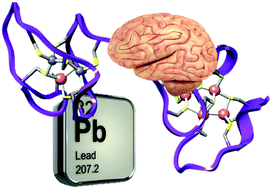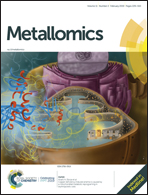Pb(ii) binding to the brain specific mammalian metallothionein isoform MT3 and its isolated αMT3 and βMT3 domains
Abstract
The toxicity of lead, one of the most ubiquitous toxic metals, is well known. Some of its pathological effects are related to its preference for the sulfhydryl groups of proteins. Metallothioneins (MT) are a particular family of metalloproteins characterized by their high Cys content that, among other functions, are linked to the detoxification of heavy metals. In mammals, 4 MT isoforms have been found. The MT3 isoform, also called “neuronal growth inhibitory factor”, is mainly synthesized in the brain and contains several structural differences that may contribute to important functional differences between it and other MT isoforms. The abilities of recombinant MT3 and its individual αMT3 and βMT3 fragments to bind Pb(II) have been investigated here, under different pH conditions, by means of spectroscopy, mass spectrometry and isothermal titration calorimetry. The results obtained show that the binding of Pb(II) to the intact MT3 protein is relatively unaffected by pH, while the individual domains interact with Pb(II) in a pH-sensitive manner. The mass spectrometry data reveal the evolution with time of the initially formed Pb-MT complexes. In the case of the full length protein, Pb(II) remains bound for a long period of time. With the isolated fragments, the lead is eventually released. The Pb-species formed depend on the amount of Pb(II) present in solution. The thermodynamic data recorded, as measured by ITC, for the replacement of Zn(II) by Pb(II) in reactions with Zn-MT3, Zn-αMT3 and Zn-βMT3 are all similar, and in all cases, the displacement of Zn(II) by Pb(II) is thermodynamically favorable. Zn-Replete and Pb-replete MT3 have distinctive circular dichroism spectra, suggestive of structural differences with different metallation status.

- This article is part of the themed collection: In memory of Silvia Atrian


 Please wait while we load your content...
Please wait while we load your content...
